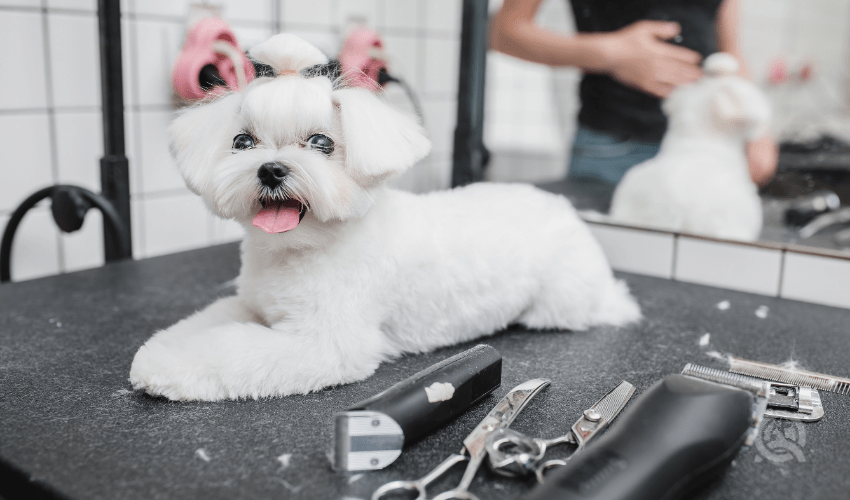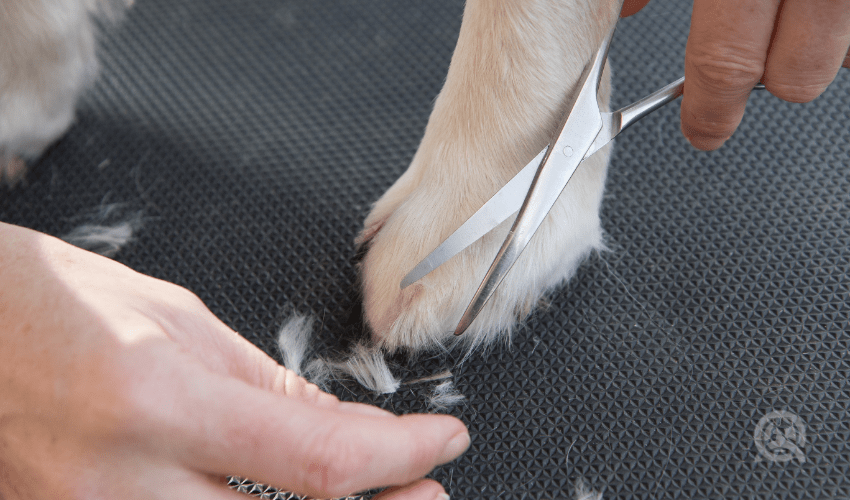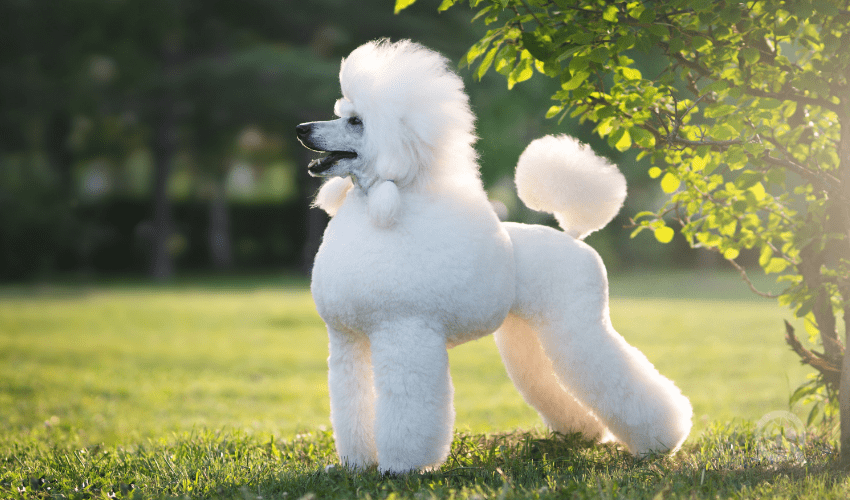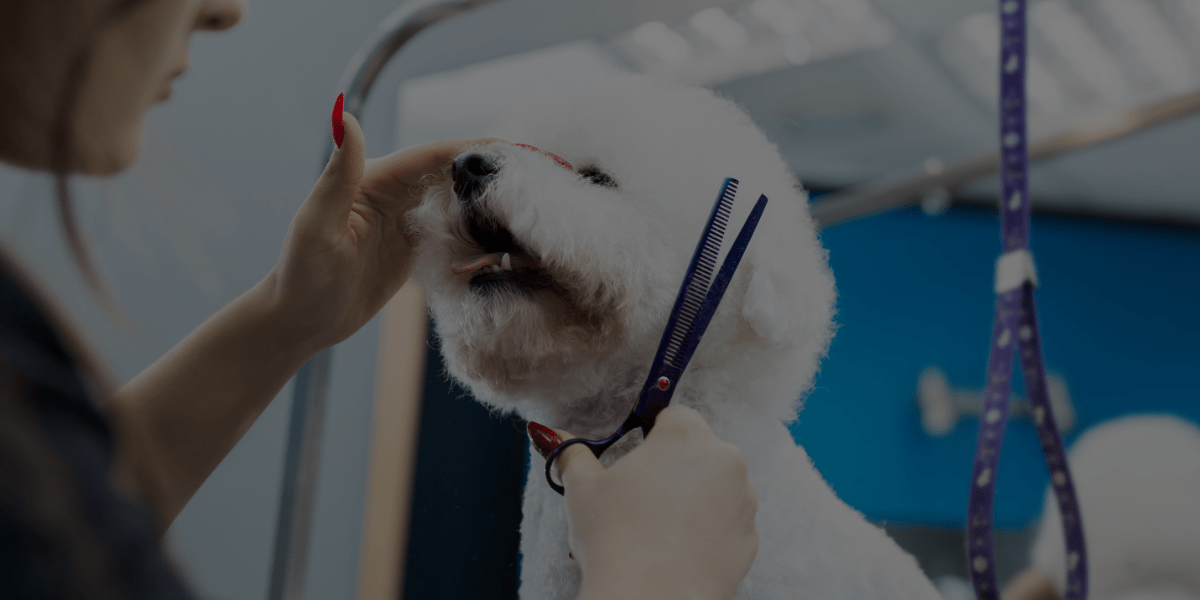As a professional groomer, you’re going to be responsible for countless dog haircuts over the course of your career. With the proper training and education, you can make Fluffy look her very best! Without it, though, your client’s dog can walk out looking like a bit of a train-wreck (to put it nicely).
Don’t worry, though, we’ve got you covered! Let’s break down the basic elements you absolutely need to do about dog haircuts. As a bonus, we’ll even reveal to you the #1 secret to becoming a clipper-wielding wizard!

When you have your client consultation, you’ll be able to learn more about their dog and ask the right questions to best determine what haircut would be the best fit. Sometimes it has to do with the breed; other times, it’s the dog’s health, lifestyle, and/or coat condition you need to factor in. And of course, sometimes it just boils down to your client’s preferences!
With time and experience, you’ll be able to look at a dog, know exactly which questions to ask, and confidently know the types of haircut to recommend.
What’s in a Name?
Because there are tons of different dog haircuts, there are tons of different haircut names. While many of them are undeniably cute (such as the “teddy bear” haircut or the “bikini cut”), they’re admittedly a bit ambiguous.
Contrary to popular belief, there isn’t really a “one size fits all” way to do any single cut. A client can walk into a salon in one city and ask for a teddy bear cut, and get one thing. But another client on the other side of the world can ask for the same haircut and get different results. It really depends on region, the groomer’s expertise, and the individual’s preferences.
If your client requests a particular haircut, your best bet is to discuss it with them first and make sure they understand what you’d be doing, and how that haircut will look at the end. It’s a good idea to keep pictures of standard cuts on hand, to make sure the owner’s vision matches your own! This way, everyone’s on the same page. You can ensure that your client’s expectations are aligned with the realistic outcome.

Different Kinds of Dog Haircuts
Full-Body Cuts
Full-body dog haircuts define a dog’s overall look, since they alter the length of the coat on the face, body, legs, and tail. Some popular full-body cuts include:
- The teddy bear cut
- The shave
- The kennel cut
- The lamb cut
- The poodle cut
- The sporting cut
- The bikini cut
Head Cuts
Clients may come in and in terms of a trim, request nothing but a head cut. Alternately, you may be pressed for time during the appointment. Either way, if a haircut is requested, tending to the dog’s face is always a priority. That is, after all, the part of the dog’s body where your client tends to focus on most in day-to-day life!
The goal with all head cuts is to choose a style that attractively enhances the dog’s natural expression and head shape. For dogs with long hair, it’s also a safety measure to clear out any unwanted fur that’s shielding their eyes and impeding their vision. Just make sure to take extra care and precaution when using any of your grooming tools near a dog’s face. It’s a very sensitive area, after all!
Common head cuts you’ll perform throughout your career will include:
- The clean face
- The topknot
- Tipped ears

Foot Cuts
Too much hair on a dog’s feet and pads can lead to decreased traction, in addition to an increase of tangling. Foot cuts help to prevent this, as well as help keep the dog’s feet cleaner overall! Your dog grooming training will help you differentiate the different kinds of dog breeds, and how those breeds determine the ideal shape and appearance of the foot.
The clean foot and the round foot, for example, are both standard foot cuts you’ll come across.
Hygiene Cuts
These type of dog haircuts are usually needed when hair needs to be removed from a specific area on the body, in order to keep the dog healthy and clean. Here are a few examples of different hygiene cuts, and why they’re needed:
- The maternity cut – performed on pregnant dogs, and done by shaving the dog’s belly from the armpits to the groin. This particular cut exposes her nipples to her pups, while also ensuring that the area remains clean while she is nursing.
- The sanitary cut – involves trimming the hair around the dog’s genitalia, to prevent urine, feces, and other unwanted debris from getting tangled in the fur.
- The T-cut – involves gently clipping the hair under the dog’s armpits, followed by a line straight down the stomach (forming the letter ‘T’). These areas are often forgotten by owners when brushing, and can be prone to matting. The T-cut prevents this, allowing the dog to be more comfortable.

The Secret to Becoming a Clipper-Wielding Wizard is…
Getting proper training, of course!
(Really, are you at all surprised by this answer?)
An education in dog grooming is an excellent way to stay ahead of the competition and impress your clients. Even more importantly, it strengthens YOUR skill-set and makes you the best dog groomer you can be!
After all, in this industry, it’s not enough to simply love dogs. You absolutely have to know what you’re doing, too! When you have both of these things, there’ll be nothing that can stop you!

I have two pet miniature poodles, I am pensioner and interested in doing a course or workshop so I may clip my poodles, do their ears and nails. I was wondering how much a basic course or workshop would cost that could help me maintain my pets.
Where do you conduct these courses.
Regards, Marilyn Wilks
Hi Marilyn, thanks for commenting! 🙂 Our courses are done virtually, allowing you to focus on your studies wherever you’d like (such as the comfort of your own home). Our courses are also 100% self-paced, in order to fit with any schedule you may have! You can check out our courses and figure out what the pricing would be (based on your location) here: https://bit.ly/2EY8NAT
You’re also welcome to email us any time at info@qcpetstudies.com, and our Student Support Specialists would be more than happy to provide you with more information about our school, courses, etc. 🙂
All the best,
The QC Team